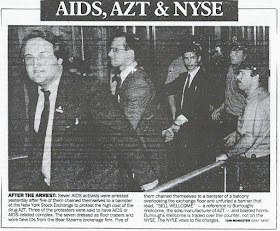As a general-interest reporter, you have to cram knowledge and then discard it to make room for the next story, and you have to move on.
But at a book reading in Greenwich Village last night, I was bracingly reminded why some stories you do just matter more, and stick to your guts. Most of my tenure was spent covering pop culture, which certainly is important to a lot of people, but is rarely life-or death.
Not so this story.
 |
| My first meeting & demonstration |
I just dug up a paper pocket calendar to find the date - November 6, 1989 - (right) that I first attended a weekly meeting of ACT UP - the AIDS Coalition To Unleash Power - which had formed in March 1987.
I had been assigned to write a longform piece by Rolling Stone. I think one of my editors, Susan Murcko, had brought in a clipping about the group from the Village Voice. Or maybe the Times.
I wanted to suss out who was who and what was what, and the best way was to attend the open, democratic, freewheeling, sometimes fractious, often cruise-y Monday night forum at New York's Gay & Lesbian Community Center at 208 West 13th Street. It was run by "facilitators" and everything was decided by majority vote, after kicking off with the request that any undercover cops identify themselves (none ever did).
The facilitator, Ann Northrop - a lesbian former debutante and TV news producer - described ACT UP to those in attendance as "a diverse, nonpartisan group of individuals united in anger and committed to direct action to end the AIDS crisis."
All true.
A few weeks earlier, in September, seven members of ACT UP had donned fake IDs and worn suits to infiltrate the New York Stock Exchange, chaining themselves to the VIP balcony and unveiling a banner saying "SELL WELLCOME," a reference to the pharma company Burroughs Wellcome which made the only approved AIDS drug at the time, and had priced it at $10,000 per patient per year. Meanwhile compariots outside staged a "die-in" blocking traffic. Many traders angrily screamed things like 'Die, faggots!' and 'Mace them!' |
| Wall Street, Sept. 1989 |
But a few days later, Wellcome lowered the price of its drug by more than a third.
This -- was impressive.
It turned out that the leader of that action, Peter Staley, knew what would be impactful because he had worked on Wall Street as a closeted gay man and had been participating in ACT UP secretly until his t-cell count got so low that he quit to become a full-time activist.
Staley was exactly my age - 28 - charismatic, impassioned, articulate - and in the fight of, and for, his life.
Just two days later, I attended my first demonstration, and my story was off and running.
A month later, I was with ACT UP inside St. Patrick's Day Cathedral for their choreographed "Stop The Church" interruption of mass led by Cardinal John J. O'Connor, who had opposed teaching of safe sex in schools and condom distribution. 4500 protesters showed up outside, and 111 were arrested.
The impact got muddied when, during communion, a renegade member threw a wafer angrily to the ground, which enabled critics - and President George H.W. Bush - to say they'd gone too far. But they of course got more publicity for it.
As I continued to report, I naturally found myself focusing on individuals -- most of them leaders, like co-founder playwright Larry Kramer, Staley, and Northrop, and Mark Harrington and Jim Eigo of the "Treatment and Data" committee, who were monitoring the status of medications and trials.
But I also found interesting Natasha Gray, a 25-year-old Bryn Mawr grad who hadn't known anyone with AIDS, who had gotten involved through the issue of housing for the homeless, many of whom were now becoming infected. Gray talked to me both about how empowering the group was in terms of self-education, but also about how she now was dreading losing her new friends to the illness. I decided to include her as a point of entry for readers like her.
 |
| Fauci |




















